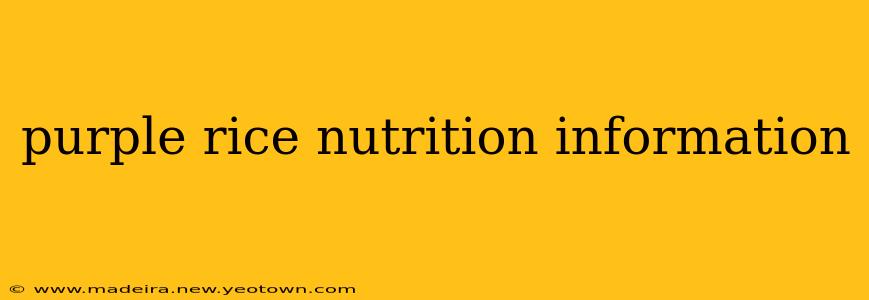Purple rice, a visually stunning grain with its vibrant hue, isn't just a feast for the eyes; it's a nutritional powerhouse brimming with health benefits. Its deep color comes from anthocyanins, potent antioxidants also found in blueberries and cranberries. But purple rice offers a unique nutritional profile, making it a worthy addition to any healthy diet. Let's delve into the fascinating world of this ancient grain and explore its nutritional riches.
What are the nutritional benefits of purple rice?
Purple rice boasts a nutritional profile significantly richer than its white counterpart. It's a good source of fiber, essential for digestive health and helping regulate blood sugar levels. It's also packed with various vitamins and minerals, including manganese, magnesium, and selenium. However, its claim to fame lies in its impressive antioxidant content, primarily from anthocyanins. These compounds are linked to a reduced risk of chronic diseases like heart disease, cancer, and neurodegenerative conditions. The antioxidants combat oxidative stress, protecting cells from damage caused by free radicals.
Is purple rice healthier than white rice?
Yes, generally speaking, purple rice is considered healthier than white rice. While both provide carbohydrates, purple rice significantly surpasses white rice in its fiber, antioxidant, and micronutrient content. The refining process that transforms brown rice into white rice removes much of the nutrient-rich bran and germ layers, leaving behind primarily carbohydrates. Purple rice, on the other hand, retains these nutrient-dense layers, contributing to its superior nutritional profile.
How many calories are in purple rice?
A cooked cup of purple rice typically contains around 218 calories. This calorie count is comparable to white rice, but the difference lies in the nutritional density. While the calorie count is similar, purple rice offers significantly more fiber, vitamins, and minerals, making it a more nutritious choice.
What are the health benefits of eating purple rice?
The health benefits of purple rice stem from its rich nutrient composition:
- Improved Heart Health: The anthocyanins and fiber in purple rice contribute to heart health by lowering cholesterol levels and improving blood pressure.
- Enhanced Antioxidant Protection: The high concentration of antioxidants helps protect cells from damage, reducing the risk of chronic diseases.
- Better Blood Sugar Control: The fiber content helps regulate blood sugar levels, making it a beneficial choice for individuals with diabetes or those at risk of developing it.
- Improved Digestive Health: The fiber promotes healthy digestion and prevents constipation.
- Potential Neuroprotective Effects: Some studies suggest that anthocyanins may have neuroprotective properties, potentially reducing the risk of neurodegenerative diseases.
How can I incorporate purple rice into my diet?
Incorporating purple rice into your diet is surprisingly easy. You can use it as a direct substitute for white or brown rice in many dishes. Try it in:
- Bowls: Create delicious and nutritious bowls with various toppings like vegetables, protein, and a flavorful sauce.
- Salads: Add cooked purple rice to your favorite salads for added texture and nutrition.
- Stuffing: Use purple rice as a base for savory stuffings in poultry or vegetables.
- Desserts: Though less common, purple rice can even be incorporated into some desserts for a unique twist.
Purple rice isn't just a visually appealing grain; it's a functional food with a wealth of health benefits. Its vibrant color is a testament to its high antioxidant content, offering a delicious and nutritious way to enhance your diet. So next time you're planning a meal, consider the nutritional powerhouse that is purple rice. Your body will thank you.

